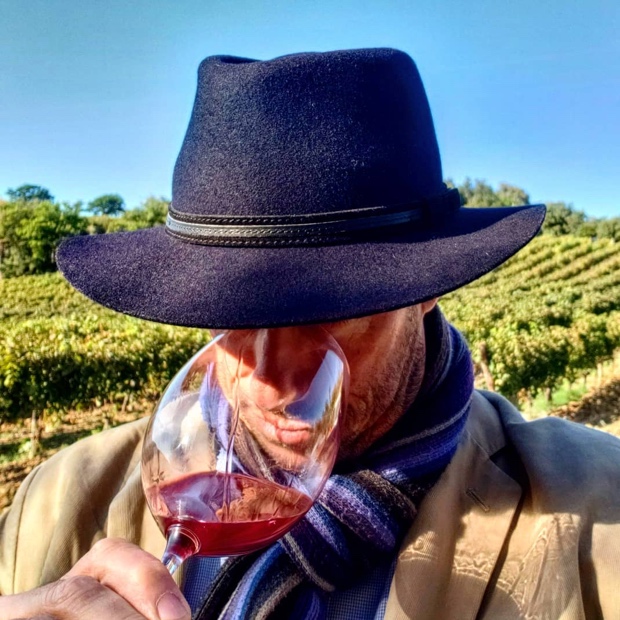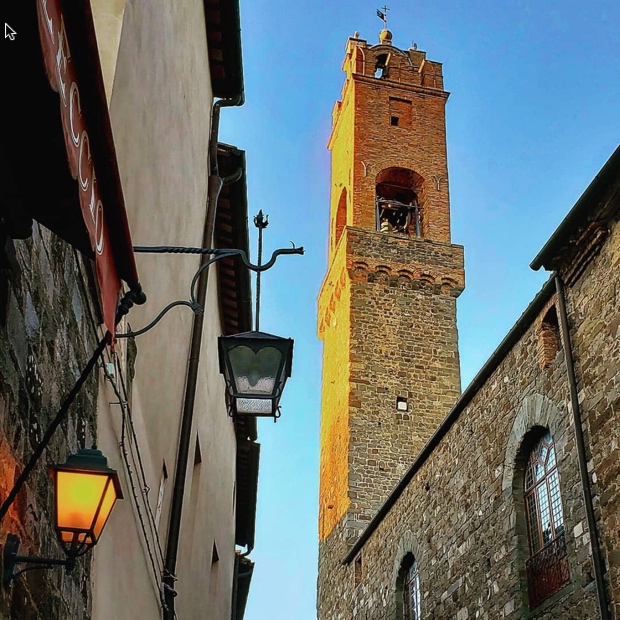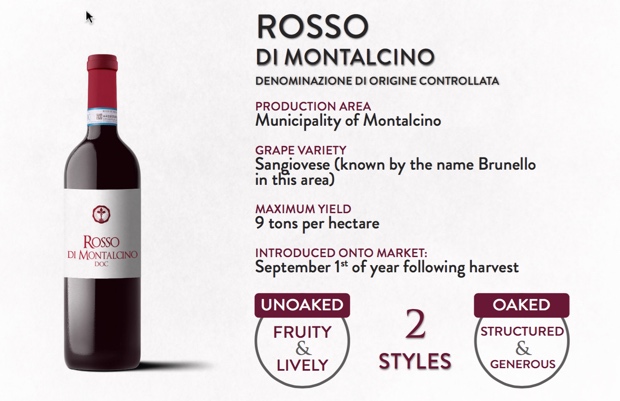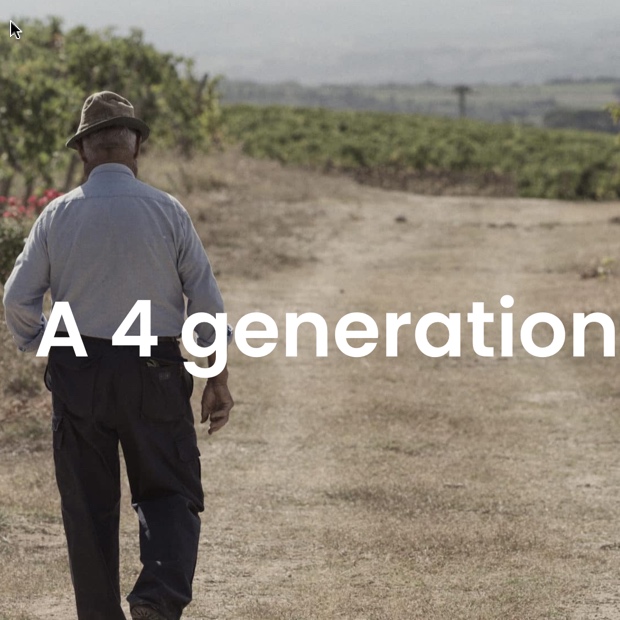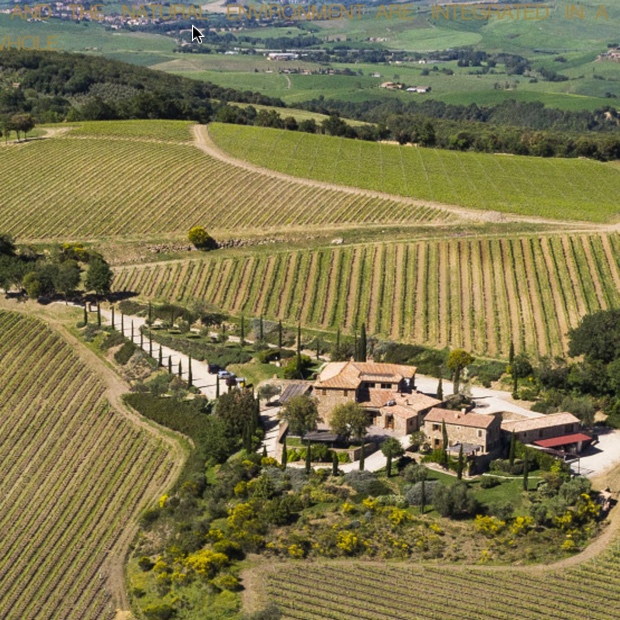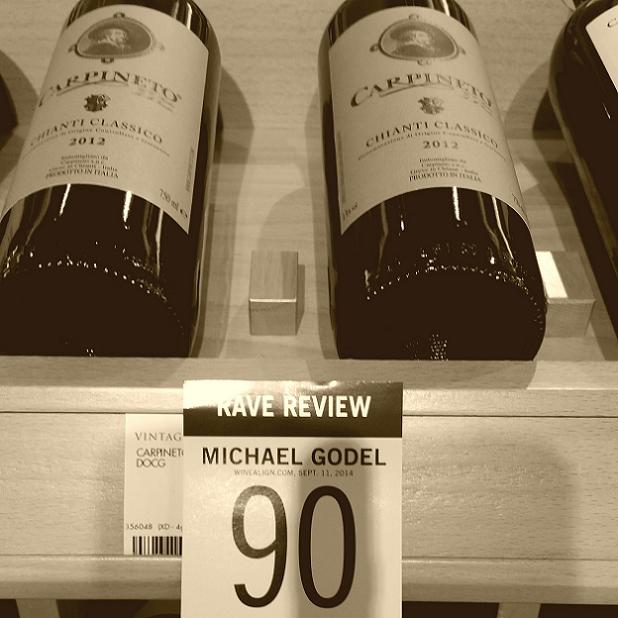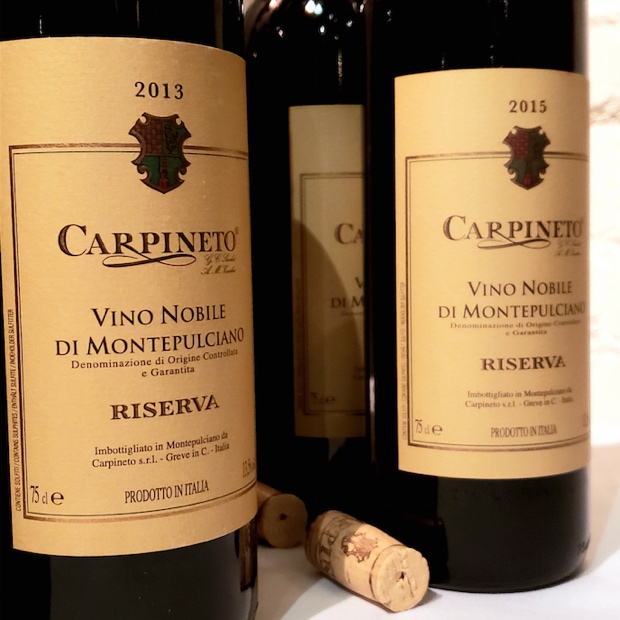Culturally speaking Rosso di Montalcino is the most important wine: It’s what the Montalcinese drink daily
It’s a Monday night, a winemaker’s night off. There is work to be done in the morning so it wouldn’t be prudent to drink anything heavy or expensive. What to open? The answer is obvious and easy. Rosso di Montalcino. More than one Montalcino winemaker has used the phrase “it’s what we like to drink” and just as many will tell you that Rosso must reflect sangiovese’s character more than any other wine. What we know is that the Rosso are the protagonists of the new market. On Monday, November 23, 2020 I will play host and moderator for the third of six online seminars covering all aspects of Montalcino, with the help and support from 25 producers and their sangiovese wines. “What the winemakers drink: Rosso di Montalcino” will celebrate the region’s young sangiovese. The webinar will welcome winemaker and Consorzio Vice-President Giacomo Bartolommei with his Caprili Rosso 2018; Brunello, Montepulciano and Chianti Classico producer Antonio Michael Zaccheo Jr. and his Carpineto Rosso 2016; Robin Shay of San Polo with their Rosso 2017; and for comparison, Alessandra Angelini be will showing her Altesino Brunello 2015.
Related – Backstage pass to Brunello di Montalcino
Montalcino. Harmony and Unesco Heritage Centre of a surface area totalling 31,200 hectares, 3,660 of which are vineyards planted predominately to sangiovese. An accord of 2,100 to Brunello di Montalcino and 510 for Rosso di Montalcino, delineated and defined in consensus by the late 1990s, set into the Galestro, Arenaria and Calcare soils on hills and over valleys in surround of its medieval village. The merits of change, alteration or expansion have been debated, voted upon and ultimately dismissed every three years and so there has yet to pass any thought of increase or reconfiguration. Neither for Rosso nor for Brunello. Montalcino. Village at 564 metres above sea level and many vineyards reside at a similar altitude. Plots, blocks and Italy’s most famous village overlooking great swaths of rolling valleys; Asso, Orcia, Arbia, Ombrone. The first known wine label dates back to the 1800s and the DOC was recognized in 1966. Brunello was afforded DOCG status in 1980, Italy’s first, followed by Rosso as a DOC in 1984.
Related – Boomers, Gen Xers and Millennials: 40 years of Brunello di Montalcino DOCG
What we know is that the Rosso are the protagonists of the new market
Related – Benvenuto Brunello 2020: Montalcino surges ahead
Brunello’s maximum yields are eight tonnes per hectare (approximately 52 hl/ha of wine) and the aging requirement is five years (six for Riserva), of which two must be in oak barrels, followed by four months in bottle. It may be introduced to market on January 1st of the 5th year after harvest (January 1st of the 6th year for Riserva). Rosso’s maximum yields are nine tonnes per hectare and it may be introduced to market on September 1st of the year after harvest. There are nine million bottles of Brunello and half that of Rosso produced on average each year. More than a quarter are certified organic and/or biodynamic and that is double as compared to just five years ago. Seventy per cent of the wines are exported. Current vintages on the market are 2015 for Brunello, 2018 for Rosso.
The most fascinating thing about Rosso di Montalcino is that every producer has a unique philosophy and a personal relationship with the appellative wine. To some it persists in the old-school way, that is to think of it as a “baby Brunello,” or second wine, if you will. The days of Rosso being considered only in this way are long past. The baby Brunello concept now acquiesces to the notion of Rosso strictly made for Rosso, with great purpose and also meaning. There are some Rosso that really need to be considered and assessed just as you would Brunello and it is only where such structured sangiovese fit relative to the estate’s other Brunello that need qualify it as Rosso. In today’s Montalcino one’s Rosso is another’s Brunello. It’s now more than ever a matter of location, soil and altitude.
Rosso can refer to the sangiovese berries themselves, meaning the winemaker will pick the largest for Rosso, the medium berries for Brunello and the smallest ones for Riserva. Others will designate vineyards to the Rosso, or plant new ones and use the youngest fruit. Still there will be some who pass through all their vines and designate specific blocks, referring to it and even labelling it as a cru. Finally there are some who wait and craft Rosso in the cellar, after the fruit has come in and been pressed. There are many ways to skin a Rosso but these days it is always a wine treated with respect. In terms of elévage, Rosso will more likely than not be raised in big barrels but not the Grandi Botti often used for the Brunello. As for vine age it seems the sweet spot is between 15 and 20 years.
What about Rosso vintages?
2018: A vintage from which acceptance is required, to seek pleasure only, not to look too deep into the future. The kind of tart and tang on cherry and more cherry is what you want from sangiovese meant for the table each and every night. Freshness and youthfulness is a beautiful thing. The wildcard of 2018 is sprezzatura, which translates as contempt but refers to Rosso with old school structure and texture in defiance to the average or general lightness of vintage. Some 2018 Rosso just have that disregard for normal.
2017: The driest and hottest of vintages and so making really high quality Rosso was like Sisyphus pushing a boulder up a hill. If you did it a day late you were likely going to come up a dollar short. If you got it right you made great wine with surprising structure. Advice to Sommeliers? Don’t miss out on selling Rosso from 2017.
2016: These are Rosso for Rosso sake, discriminant, linear, and vertical. If Rosso can be spiritual they would be these, poignant and so good. In 2016 these are the acids of Montalcino and the depth of earth which holds you firm in the face of a fluent perfume. What you need to know and what you want to drink. Rosso in 2016 should be crispy and crunchy with juicy fruit in the savoury candy way up against high and ripe acids. When this happens the best of the 2016 Rosso can live for a dozen years.
2015: So many Mediterranean wine regions reaped huge benefits from the 2015 growing season but I’ve not personally seen such an across the board level of quality from a group of structured wines as I saw in the Rosso Annata. You would have to go back to 2010 to find a vintage with a near-chivalrous level of generosity and as far back as 2001 for its equal. That said I would suggest with extreme prejudice that 2015 Rosso di Montalcino is the vintage to change your mind about its quality and its ability to stand alone. As an entity, the Rosso are produced from grapes farmed explicitly for a purpose and it is this ’15 vintage that can be used to back up that very proposition. Rosso are fashioned to make a young sangiovese distinctive and antithetical to Brunello, but with the resolution to forge ahead with an intrinsic and personal level of structure. I have tasted several 2010 Rosso in the last year and their remarkable freshness shows just how long they can go.
Altesino
Located in the north of Montalcino where you can find the famous Montosoli hill and cru. Giulio Consonno purchased the property in 1970 and Altesino became part of the new Brunello revolution as one of a handful of Brunello producers who pushed for increased quality through the 1970s and into the 1980s. In 2002, the winery changed hands with new owner Elisabetta Gnudi Angelini taking over, adding to Tenuta Caparzo she owned nearby, also to the north of Montalcino. There are approximately 44 acres under vines and 220, 000 annual bottles produced under the winemaking team led by Simone Giunti and Alessandro Ciacci. Altesino is responsbile for not merely introducing but successfully marketing one of Montalcino’s most famous cru wines, Montosoli Brunello, named after the sought after vineyard. Rosso di Montalcino is a selection of sangiovese sourced from the younger vines in the Altesino, Pianezzine, Macina, and Castelnuovo dell’Abate vineyards. North and south combine for an estate Rosso.
Alessandra Angelini earned her undergraduate degree in Aerospace Engineering from La Sapienza University in Romeand participated in research projects designing Formula 1 cars and racing dinghies. In 2013, she began working for Rolls Royce North America designing airplane engines. In 2008 she was a member of the Italian Olympic Sailing team. She returned to the family business of wine and hospitality in 2017.
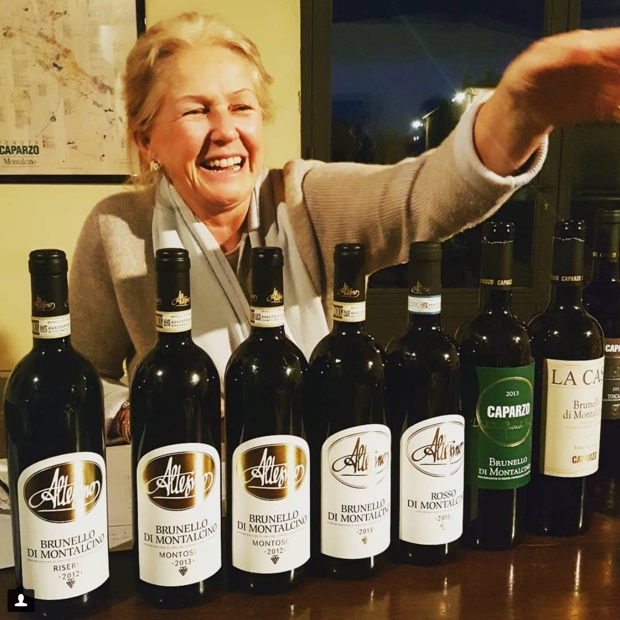
Emotional tasting through #altesino & @caparzowines with #elisabettagnudiangelini #brunellodimontalcino #montosoli #vignalacasa
Altesino Rosso Di Montalcino DOC 2018
Altesino’s is consistently rich and baritone for Rosso, even in light ’18 and gone in all for one with not much left to the imagination. An amenable, commercial and viable proposition for anyone and everyone to take part. Drink 2020-2021. Tasted February 2020
Altesino Rosso Di Montalcino DOC 2016
Generally aged right to 10 months is large Slavonian oak barrels. Takes off straight from where 2015 left us, that is to say from fruit and into more fruit, of sangiovese in wild berry form, expected and imagined. Exactitude from winemaker Alessandro Ciacci, polished, crunchy and then more tannic as a vintage. Drink 2019-2022. Tasted October 2019
Altesino Rosso Di Montalcino DOC 2015
Certainly richer and deeper than cousin Caparzo but really just a different child for Elisabetta Gnudi and just as important in its own right. This Altesino Rosso exhibits the ’15 freshness but with a year further under wing it has settled and added some weight, albeit in liquidity, sweet, viscous liquidity. So much joy here. Drink 2018-2021. Tasted February 2018
Altesino Brunello Di Montalcino DOCG 2015
Very polished and made Brunello with a wealth of statuesque parts sculpted out of the high level materials presented the team that crafts this wine. Speaks to a very broad swath of place and a perfectly good drink of consumer appeal. Last tasted February 2020
From the vintage where agriculture, winemaking and now selling came and will come easy so you can expect the warm, fuzzy, generous and soft. Perhaps too straightforward to be what the powers that be call a five-star vintage but if Brunello is what you want or even what you think you need then begin or continue the journey right here. Very berry, ultra liquorice and über morbido. Soft, amenable and unencumbered. Positive but certainly not overbearing structure. A now and through mid-term years drinking Annata. Drink 2019-2024. Tasted October 2019
Caprili
Caprili is located in the southwestern sector of Montalcino near the small village of Tavernelle. The podere dates back to 1965 after Alfo and his father Alberto Bartolommei decided to buy the property from the Castelli-Martinozzi family and split from the famous Pieve Santa Restituta estate. Alfo’s family originated from Podere Marzolo in the Municipality of Cinigiano (Province of Grosseto). In the same year they planted the first vineyard, still called “Madre” and their first bottle of Brunello di Montalcino from the 1978 harvest was put on the market in 1983. In 1997, Alfo’s children Manuele, Paolo and Paola took charge of the estate.
Fast forward another couple of generations and 23 further years to arrive in the world of current owner and winemaker Giacomo Bartolommei who is also one of three incumbent Vice-Presidents of the Consorzio Vino Brunello di Montalcino. Giacomo’s first actual vintage of Brunello was 2010 though he had been active in the family business for many years prior.
Caprili Brunello Di Montalcino DOCG 2014
Caprili is quite tense, nervous, unable to relax. It pulses with acidity and tannin, structure is certain and intensity over the moon. Welcome to one side of the tracks, the one without compromise and where Brunello is Brunello and over on the other side sangiovese is sangiovese. Drink 2020-2025. Tasted February 2019
Carpineto
Carpineto Appodati comprises five Tuscan estates; Dudda and Gaville (Greve in Chianti), Montepulciano, Montalcino and Gavorrano (Maremma). No less than 28 different wines are produced off of the five properties and while their Vino Nobile sangiovese from Montepulciano have garnered the most international accolades, it is the Rosso and Brunello that concerns us most today. After all, as noted by Antonio Michael Zaccheo, Carpineto brings “la Toscana e i suoi vini magliori” to the world.
Carpineto Rosso Di Montalcino DOC 2016
Carpineto’s 2016 comes from higher (450-500m) elevation than many, is aged longer (three years in large oak barrels) and so 2020 is just about the perfect time to enjoy its charms. This 100 per cent sangiovese off of marl and clay was picked into October and it so dutifully expresses the appellation, grape and territory. The all in fulsome red cherry is now joined by a silkiness of texture because the calcaire and the wood have softened, liquified and swirled right through the fruit. A fresh one from a structured vintage and put succinctly into that five to six years Rosso di Montalcino aging window. Drink 2020-2023. Tasted February and November 2020
Carpineto Brunello Di Montalcino DOCG 2014
Carpineto and proprietor Antonio Zaccheo Jr. produce 28 Tuscan labels on five Tuscan estates; Dudda and Gaville (Greve in Chianti Classico), Montepulciano, Montalcino and Gavorrano (Maremma). The Montalcino property is at 450m on a ridge just on the southwest corner to outskirts of the hilltop village. For 2014 it continues to swim in deep, dark and ripe waters but there is an ethereal coolness here and as such makes this a real winner for the season. Just entering an optimum window now it would be hard to figure any reason not to make this a go-to Brunello for the 20/21 and 21/22 winters. Smooth in all ways, most notably the palate and the ganache of chocolate across the finish. Drink 2020-2024. Tasted August 2020
Carpineto’s is not just an exemplary 2012, it’s a bloody delicious one. The aromatics are pure vintage-related, of the deeper than many (darkening to black) cherry liqueur and the liquid dusty pearls of all things Montalcino sangiovese fruit, acidity and tannin. A very balanced Brunello in all regards, ready to be enjoyed and blessed with structure for five years (plus) moving forward. Drink 2017-2022. Tasted October 2017
San Polo
Poggio San Polo was tarted in 2005 and is situated in Podernovi, on the southeastern slope of the Montalcino hill above the valley of Sant’Antimo with Mount Amiata looming to the south. The locals call this area a “Mezzopane,” meaning that to admire the beautiful view is to ‘take one’s fill’, like food for the soul. Two years later 2007 marked the beginning of the new era for San Polo and the Allegrini family, one of Veneto and Valpolicella’s most famous names in Fumane. The Estate is composed of two holdings: San Polo, planted in 1990 and Monteluc, planted more recently with a density of 7,000 vines/hectare, for a total of 22 hectares, The first winery in Tuscany and the second in the world to have earned the Quality Seal from the CasaClima Wine Certification. CasaClima Wine is a Quality Seal issued by the Bolzano-based agency, created to provide objective, credible evidence of the efforts made by wineries towards achieving more careful management of their business and to assess the environmental compatibility of winery buildings, comfort and suitability of work spaces, consumption of energy and water in the production of wines, choice of packaging materials, as well as the impact of transport.
San Polo Rosso Di Montalcino DOC 2017
San Polo’s Rosso grows at 400m so it speaks in a high elevation appellative voice. The wine is usually the Allegrini estate’s most floral and mineral expression of sangiovese grosso but then along comes this 2017 vintage. The usual bracing acidity is there but a tripling of warmth is the result of hot ’17, southern vineyard fruit and southern exposure. San Polo dry farms which only accentuates the atypical profile. Most accumulation ever, at least in recent times when it comes to richness, extract and colour. Not a baby Brunello but structure and power are truly there. That said its best years will be the first so get at it and defend the cellar. Drink 2020-2023. Tasted February and November 2020
San Polo Brunello Di Montalcino DOCG 2014
Lovely sweet candied rose and herbal nose to this sangiovese and for the first time some reduction. Quite intense, locked down, massive and working for a living. Give some credit to this wine. It will settle into a lovely place in a few years time. Drink 2021-2025. Tasted February 2019
San Polo Brunello Di Montalcino DOCG 2013
The vintage is a terrific one for San Polo, transparent in its fruit clarity, inflective of warm south Montalcino vineyards. Località Podernovi is found on the southern slope with Mount Amiata acting as the mitigator for winds whipping in from the sea. The vintage was not a scorcher and how this walks a neither hot nor cold line is how it finds its grace. The fruit and acids are both of the appetizing and epicurean kind, equally opposing and nicely in synch. Lovely freshness to this Brunello. Drink 2019-2023. Tasted March 2019
Good to go!
godello
Twitter: @mgodello
Instagram: mgodello
